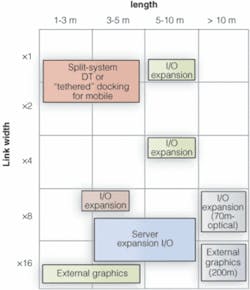PCI Express cable connects future peripherals
Andrew Wilson, Editor, [email protected]
Current work by the PCI Express Cabling Working Group under the auspices of PCI-SIG (www.pcisig.com) will soon provide a new cable-interface standard. Just as with Gigabit Ethernet, Camera Link, and FireWire, this will result in a plethora of new products, mainly from camera vendors wishing to interface to Intel’s latest PCI Express architecture. PCI Express Link resembles Camera Link, with two low-voltage, differentially driven pairs of signals-a transmit and a receive pair. An embedded data clock allows up to 2.5 G transfers/s/direction and can, according to Intel, be increased to 10 G transfers/s/direction. It is there, however, where the similarity ends.
A switched-fabric architecture, PCI Express supports scalable performance, existing operating systems, PC compatible device drivers, power management, and hot-swap capability. “Today’s PCs must also deal with multiple concurrent transfers at ever-increasing data rates,” says Ajay V. Bhatt of the Desktop Architecture Labs of Intel Corporation. “It is no longer acceptable to treat all data as equal-it is more important, for example, to process streaming data first, since late real-time data are as useless as no data.”
Realizing the need to support peripherals, the PCI-SIG Working Group, chaired by Wil de Bont, a principal hardware engineer with National Instruments (Austin, TX, USA; www.ni.com), is already at work on a cable-interface standard. Currently, the group has completed Revision 0.3 of a draft specification that defines cables and connector scheme for carrying x1 to x16 links of the Express interconnect. According to de Bont, Version 0.3 of the cable specification supports a set of additional signals for a reference clock, presence detection, and power.
“Responses from PIC-SIG members representing several market segments indicated that cabling was required to extend the PCI Express protocol and functionality across arbitrary distances and packaging,” says de Bont, “and this need cannot be met using existing backplane connectivity. We are focusing on defining standard cable connectors at first and later optical cabling connectors to provide this cabling,” he says (see figure).
Link widths and distances of the PCI Express cable standard may vary depending on application. While smart PCI Express-based cameras will initially support 7-m cable lengths, it is likely that future optical developments will lead to tethers greater than 70 m.
These connectors will support various market segments and x1, x4, x8, and x16 Link widths, with the x2 Link being supported as a subset of the x4 connector definition. Other supported features will include sideband signals for compatibility with existing silicon and operating systems and a presence detection and reference clock for hot-swap compatibility. According to de Bont, a length of 7 m seems feasible now without the use of additional equalization or repeaters to support the current 2.5-Gbits/s data rates.
“Active components such as repeaters can be used to support greater data lengths. Providing a power capability will allow active components to be implemented within the connector housing and potentially extend achievable cable length through additional equalization,” he says.
At this year’s IPOT (Birmingham, UK), many frame-grabber vendors expressed interest in PCI Express. These vendors were actively considering moving their core business from frame grabber-based boards to smart cameras that incorporated the PCI Express interface.

